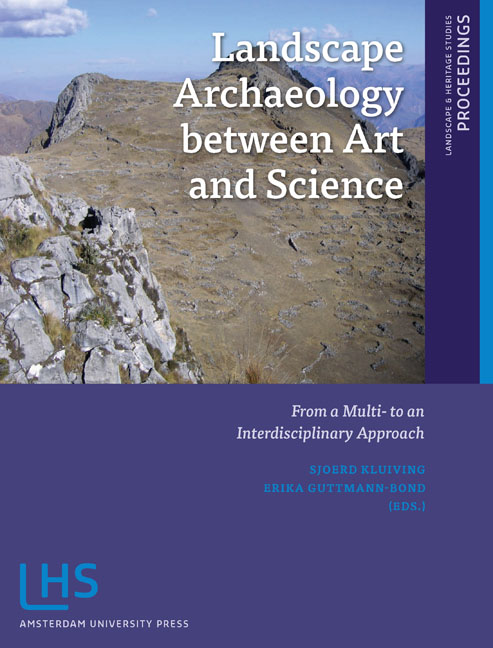Book contents
- Frontmatter
- Contents
- Preface
- Introduction: LAC2010: First International Landscape Archaeology Conference
- THEME 1 HOW DID LANDSCAPE CHANGE?
- THEME II IMPROVING TEMPORAL, CHRONOLOGICAL AND TRANSFORMATIONAL FRAMEWORKS
- THEME III LINKING LANDSCAPES OF LOWLANDS TO MOUNTAINOUS AREAS
- THEME IV APPLYING CONCEPTS OF SCALE
- THEME V NEW DIRECTIONS IN DIGITAL PROSPECTION AND MODELLING TECHNIQUES
- THEME VI HOW WILL LANDSCAPE ARCHAEOLOGY DEVELOP IN THE FUTURE?
- Miscellaneous Endmatter
3.2 - Connecting Lowlands and Uplands: An Ethno-Archaeological Approach to Transhumant Pastoralism in Sardinia (Italy)
Published online by Cambridge University Press: 21 January 2021
- Frontmatter
- Contents
- Preface
- Introduction: LAC2010: First International Landscape Archaeology Conference
- THEME 1 HOW DID LANDSCAPE CHANGE?
- THEME II IMPROVING TEMPORAL, CHRONOLOGICAL AND TRANSFORMATIONAL FRAMEWORKS
- THEME III LINKING LANDSCAPES OF LOWLANDS TO MOUNTAINOUS AREAS
- THEME IV APPLYING CONCEPTS OF SCALE
- THEME V NEW DIRECTIONS IN DIGITAL PROSPECTION AND MODELLING TECHNIQUES
- THEME VI HOW WILL LANDSCAPE ARCHAEOLOGY DEVELOP IN THE FUTURE?
- Miscellaneous Endmatter
Summary
ABSTRACT
Historical and geographical studies have stressed the pivotal role of plains (particularly coastal plains), valleys and mountains and their interconnections in Mediterranean history. However, many landscape archaeological studies have tended to focus one-sidedly on the recording of archaeological structures and artefacts in the lowlands. Allegedly, the ‘poor’ character of material culture and related to this the difficult retrieval of archaeological remains have discouraged landscape archaeologists from studying the mountainous regions of the Mediterranean. This is regrettable, because the relation between plains, valleys and mountains has been a central feature of Mediterranean rural life, especially in regions in which pastoral economies (i.e. sheep herding in particular) have figured prominently. In this article, I will discuss landscape archaeological studies of pastoral economies in the Mediterranean, with particular attention to transhumant patterns of mobility, i.e. seasonal movement of shepherds and their flocks between different regions. I will show that most studies to date have adopted ethno-archaeological approaches in order to aid archaeological interpretations of pastoral economies and their spatial features during prehistoric, classical and medieval times. I will present my ethno-archaeological research on pastoral landscapes in Sardinia, with a focus on how these landscapes have changed over the last 200 years. My contention is that it is possible to study transhumant pastoralism through archaeological methods. In addition, I will show how a landscape archaeological approach in particular can shed new light on the ways in which shepherds inhabited and exploited the countryside.
KEYWORDS
mountains, lowlands, ethno-archaeology, pastoralism, transhumance, pastoral settlements
INTRODUCTION
He tends to linger over the plain, which is the setting for the leading actors of the day, and does not seem eager to approach the high mountains nearby. More than one historian who has never left the towns and their archives would be surprised to discover their existence. And yet how can one ignore these conspicuous actors, the half-wild mountains, where man has taken root like a hardy plant; always semi-deserted, for man is constantly leaving them? How can one ignore them when often their sheer slopes come right down to the sea's edge? The mountain dweller is a type familiar in all Mediterranean literature. According to Homer, the Cretans were even then suspicious of the wild men in their mountains and Telemachus, on his return to Ithaca, describes the Peloponnese as covered with forests where he lived among filthy villagers, ‘eaters of acorns’. (Braudel 1972, 29-30)
- Type
- Chapter
- Information
- Landscape Archaeology between Art and ScienceFrom a Multi- to an Interdisciplinary Approach, pp. 249 - 264Publisher: Amsterdam University PressPrint publication year: 2012

